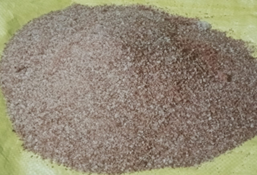About INM
About INM
Background
• Integrated nutrient management has become key factor for enhancing sugarcane productivity and increasing the soil fertility. The integrated use of organic and inorganic plant nutrient sources not only recycles organic waste but also conserves rich pool of nutrients resources, which can reduce the sole dependence on chemical fertilizers. The integrated use of chemical, organic and biological sources of nutrients and their efficient management may have positive impact on sustaining sugarcane productivity and maintaining soil health.
• Sugarcane being a heavy feeder and long duration crop suffers from persistent nutrient unbalance due to gap between nutrient removal and application. The crop is long duration and nutrient exhaustive.
• The frequent and excessive use of chemical fertilizers has created various problems like widespread deficiency of secondary and micronutrients, decline in crop productivity and increasing environmental pollution.
• Continuous sugarcane cropping with imbalance use of fertilizers and the lack of organic matter application had led to depletion of soil fertility and posing threat to the long-term productivity.
• The deterioration in soil health and ecology has been reported in recent years mainly due to erratic and imbalance use of chemical fertilizer. The yield of sugarcane has reached a plateau due to decline in factor productivity. The loss in organic matter is the root cause for decline in factor productivity. Restoration of soil organic matter is thus, needed for improving productivity through correction of essential macro and micronutrients deficiencies and improvement in soil health.
Low productivity
• There are several reasons of low productivity of sugarcane in Bihar. Continuous use of fertilizers and plant protection chemicals potentially impaired the soil microbial activity, leading to poor soil health. The alluvial sandy loam calcareous soils of Bihar are deficient in micronutrients and low in organic matter. In Bihar the Zinc deficiency is about 44.0%. Boron deficiency is also emerging in calcareous soil of Bihar, Sulphur deficiency is widespread in almost all types of the soil, crops and cropping system.
• A great part of applied fertilizer remains in soil as unutilized by the crop. Therefore, it would be desirable to optimize the nutrient-use efficiency and curtail the cost of fertilizer for making the system more remunerative.
• The long term experiment on sugarcane clearly indicated that neither the chemical fertilizer alone nor the organic sources exclusively can achieve production sustainability of soil and crop. It is imperative to substitute a part of N fertilizer by locally available organic sources of nutrients viz., manure, crop residue, and biofertilizers in a synergistic manner.
• Several elite varieties of sugarcane have been developed with a potential of producing cane yield of about 90-100 t/ha. One of the reasons for low yield of sugarcane in Bihar is mainly due to lack of application of organic nutrient sources and erratic & unbalanced use of chemical fertilizer without soil testing.
• The decline in organic matter and available nutrient especially nitrogen is root cause of low productivity. Secondly, soils of sugarcane growing areas are rich in free CaCO3 resulting in low availability of available P and micronutrient especially Zn. Currently deficiency of B has been reported from many parts of India which underline the need of B fertilization. In addition, the continuous mining of nutrients under intensive sugarcane plant-ratoon system leads to deterioration in fertility status and negative nutrient balance of soil.
Integrated nutrient management:
• Integrated nutrient management (INM) is maintenance of soil fertility and plant nutrient supply to an optimum level for sustaining desired crop productivity through optimization of all possible sources of plant nutrients in an integrated manner. The main objective of integrated nutrient management is to improve and sustain soil fertility for providing a sound basis for crop production systems and to meet changing needs.
• The basic principle of INM is the maintenance of soil fertility, sustain agricultural productivity and improve farmers’ profitability through judicious and efficient use of chemical fertilizers, organic matter, green manures and biofertilizers. It uses the inputs available on the farm and also purchased externally in the most efficient manner to obtain productivity and profitability in as sustainable manner over a long period of time with minimizing adverse effects on the environment. Thus, combined use of chemical fertilizers and nutrient recycling of organic waste materials can be and effective approach to combat nutrient depletion and promote sustainable sugar productivity.
• In sugarcane growing areas, there is an ample scope for recycling back of some organic wastes (viz. press mud, sugarcane trash, biocompost, etc.) in soil and integrated application of sugarcane waste may reduce the use of chemical fertilizers and improve sugar productivity.
Basic objective of INM
• To reduce the inorganic fertilizer requirements
• To restore organic matter in soils
• To enhance nutrient use efficiency
• To maintain soil or enhance soil productivity through balanced use of mineral fertilizers combined with organic and biological sources of plant nutrients.
• To utilize the potential benefits of green manure, leguminous crops, crop residues and biofertilizers
Components of INM:
The relative contribution of each component to INM for a forming system depends mainly on their local availability and socio-economic factors. The major components of INM are fertilizer, organic manures, and biofertilizers. Recycling of sugar industry wastes can be gain fully utilized to enhance sugarcane productivity and reduce the cost of cane production on account of fertilizers.
Components of integrated nutrient management
Chemical fertilizers Urea, DAP, SSP ,MoP and other N,P and K fertilizer, Micronutrients
Organic manures FYM, Compost, Veremicompost & different oil cakes
Greenmanuring In situ manuring- Sunhemp, Sesbania, Dhaincha, Cowpea and Moongbean
Greenleaf manuring - Leucaena, Gliricida and Subabul
Crop residues Sugarcane trash /other crop residue
Biofertlizers N fixing: Rhizobium, Azotobactor, Azospirillum, Acetobactor, BGA, Azolla
P solubilizing/mobilizing (PSB or PSM and VAM)
Plant Growth Promoting Rhizobacteria (PGPR)
Leguminous crop Greengram, Lentil, cowpea and gram etc
Sugar industry waste Pressmud, Biocompost
Use of mined and industrial wastes Gypsum, phospho-gypsum, Pyrites, Rock phosphate , basic-slag and fly ash etc
Need of INM
• High nutrient turn over in soil-plant system coupled with low and imbalance fertilizers use.
• Emerging deficiencies of micro and secondary nutrients (S, Zn, B and Fe).
• Soil degradation due to acidification, aluminum toxicity, soil salinization, alkalinization and soil erosion.
• Wide nutrient gap between nutrient demand and supply
• Deterioration in soil physical, biological and chemical quality.
• Low fertilizer use efficiency



